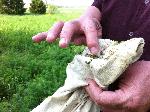COLUMBIA, Mo. – This time of year Larry Godsey gets a lot of calls from woodland owners asking for advice about taxes on timber they have sold.
Godsey, an economist with the Center for Agroforestry at the University of Missouri, usually starts by asking, “What is your basis?”
A lot of woodland owners don’t know, and that means they could be selling their timber for too little, and paying too much in taxes.
Put simply, the basis, also known as the tax basis, is what you invested in an asset. “Basically, it’s what you paid for it or its fair market value on the day it was acquired,” Godsey said.
While many woodland owners probably have the basis for their entire property—which might include cropland and buildings as well as forest—they may not have established what portion of the original purchase price went to acquiring the timber.
Timber is usually taxed as a long-term capital gain, so you can subtract the cost basis when figuring your tax liability. But if you don’t have the basis, you have to pay tax on the full amount of the sale.
Flooding and tornadoes took out a lot of trees in 2011, and you can declare those trees as a casualty loss—but again, only if you have a basis.
It’s possible to establish a cost basis retroactively by hiring a forester to cruise the timber and “ungrow” the trees, but that can be expensive.
“When you acquire the property, hire a consulting forester to estimate the volume and value of your timber,” Godsey said. You can adjust your basis to reflect additional investments—including the forester’s fee.
If you have inherited the woodland, and therefore didn’t pay anything at all to acquire your timber, you can still establish a cost basis using the appraised market value of the timber, he said.
Call before you cut
“Never sell timber without assistance from a consulting or professional forester,” Godsey said. “A lot of landowners may not know what their timber is worth. Don’t sell to the guy who knocks on your door and says, ‘I’ll give you $3,000 for your timber.’
“Call someone who knows about forest taxes and say, ‘I’m ready to do a timber sale. What do I need to know?’ That way, if you have to go back and establish a basis, you can do that before the trees are cut and gone instead of looking at stumps and trying to estimate if they’re oak or walnut or what.”
For more information about timber and taxes, Godsey recommends Internal Revenue Service publication 225, Farmer’s Tax Guide, available at www.irs.gov/publications/p225/.
Woodland owners might be interested in these MU Extension publications, which are available for free download at extension.missouri.edu/publications/:
Read more http://extension.missouri.edu/news/DisplayStory.aspx?N=1348





